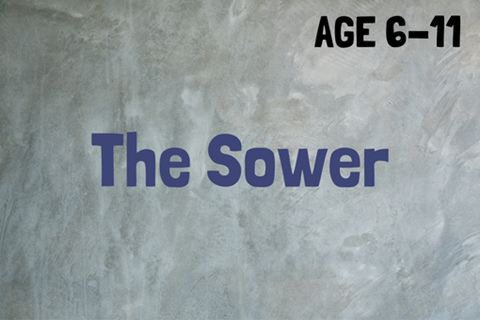
Subscribers only: Download as a PDF here.
BIBLE PASSAGE: Matthew 13:1-9
BACKGROUND: We often think about this parable when looking at ways of reaching others with the message of Jesus. However, we also need to ensure that we are growing healthily as followers of Jesus. A sign of healthy growth is that we automatically ‘self-seed’ and make disciples as we live out our everyday lives in the way Jesus asks us to.
CIRCLE TIME
Welcome the children by name and share out any refreshments you have brought. Ask the children about their week, then ask them to mime what they ate for breakfast. The rest of the group must guess!
INTRO ACTIVITY
You will need: inflated balloons; several soft footballs; tape or chairs to be a ‘garden fence’
Divide the room into two ‘gardens’ using the chairs or tape. Split the children into two groups and show the groups which side of the room their garden is on. Their garden is special and they have some important flow- ers growing, but the snails and footballs from next door keep invading it. Their job is to keep the snails and footballs out!
Empty the balloons and balls into the middle of the room. When you shout “Go!” or blow a whistle they must throw the balloons and balls over the garden fence. Give them
a time limit and then blow the whistle again.
Count how many balloons and balls are left. The garden with the fewest snails and footballs is the winning team.
BIBLE STORY
You will need: one clipboard per group; wheat seed; a bag of flour; four pots with plenty of seed in; bird sound effects; grey or brown cloth to represent a path; rocks; two torches or lamps; two seed bed trays or similar; compost; a watering can; weeds; question sheets (see below)
Before the session, make up some question sheets asking:
- Where has the seed been planted?
- Does the seed have (tick as appropriate): Sunlight?
Water? Good soil? Oxygen?
Space to grow?
- Are there any dangers to growth here? If yes, what are they?
- What do you think will happen to the seeds?
Gather the children together and show them a wheat seed. Discuss what it will grow into. Then show the group the bag of flour and discuss all the things we can make from flour.
Say: “It all starts with a seed. What does a seed need to grow? Jesus told a story about seeds. In his story, the seeds fell in different places. In each area there was a different result.”
Explain that the children are going to be garden investigators, visiting the different places Jesus talked about. In groups, they should to think about what the outcomes might be for the seeds and write their thoughts down. Give each child a question sheet.
Garden one: If you can access an outside area, use a real path or make a ‘path’ out of material. Play some bird
sounds. Ask the children to throw some seeds from the pot onto the path. Read out Matthew 13:4 and give the children time to fill in their sheets.
Garden two: Pile up some large stones and rocks. Use a torch or lamp to shine on the area to imitate the sun. Ask the children to throw the seeds onto the rocks. Read out verses 5 and 6, then answer the questions again.
Garden three: Fill a seed bed tray or similar with compost and plant some weeds in the soil. Ask the children to throw the seeds into the soil. Read out verse 7 and answer the questions again.
Garden four: Fill a seed bed tray or simi- lar with compost. Place a filled watering can beside it. Shine a torch or lamp onto the area to imitate the sun. Ask the children to throw seeds into the tray. Read out verse 8 and answer the questions again.
Finally, review the sheets together.
CHATTING TOGETHER
Discuss the story further using these questions:
- What do the seeds represent?
- What do you think the different areas where the seeds landed mean?
- What kind of soil / area are you?
- What makes good soil?
- What could the seeds grow into?
- What is Jesus teaching us through this story?
CREATIVE RESPONSE
You will need: one small plant pot per child; compost; daffodil bulbs; a watering can; two stickers per child
On one sticker, answer the question: “How can we be good soil?” On the second, answer the question: “Where can we throw our seeds?”
The children should fill each plant pot with compost, plant a daffodil bulb and stick their responses onto the pot. As they work, continue chatting about the story. When do they feel like good soil? When do they feel like weeds are choking them or the sun is burning them? (You may need to help children who are struggling with the metaphors with this.)
Encourage the children to take their pots home, put them outside, watch them grow and remind themselves to be good soil. (Explain that they will have to wait until the spring for the bulb to grow.)
PRAYER
You will need: wooden lollipop sticks Give the children a handful of sticks. Ask them to write their names on one and to write and the names of anyone else they might think of as ‘seeds’ on the others.
Take the sticks and place them in the gardens they feel best match the person whose name is on the stick. Pray together for these people.
Supporting documents
Click link to download and view these files1004236.pdf
PDF, Size 0.43 mb




























